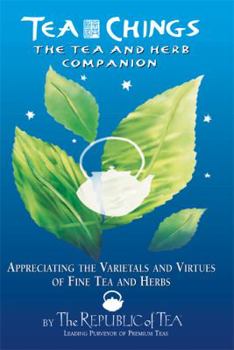Tea Chings: The Tea and Herb Companion: Appreciating the Varietals and Virtues of Fine Tea and Herbs
Presents a history of tea and herbs, and includes information on brewing tea, tea varieties, and the health benefits of tea and herbs. This description may be from another edition of this product.
Format:Hardcover
Language:English
ISBN:1557044910
ISBN13:9781557044914
Release Date:January 2002
Publisher:Newmarket Press
Length:195 Pages
Weight:0.80 lbs.
Dimensions:0.8" x 5.8" x 8.8"
Customer Reviews
4 ratings
For Those Mindful About Their Diet
Published by Thriftbooks.com User , 15 years ago
This book talks a lot about true Camellia Sinensis teas with a little touch of history thrown in. But what makes it a valuable resource is how it covers other herbs that are commonly made into tea. Many plant foods have healing properties that are sadly neglected by modern Western medicine. When you're mindful about what you eat and drink, you'll want to know how to nurse yourself back to health and prevent disease. This book helps. I give it my approval because Puerh doesn't get relegated to a lower class as it does in many books about tea. Puerh is often considered medicinal and that's the very reason tea has exploded in popularity recently in the US. It's now proven to be best for your health.
The I Ching in a cup?
Published by Thriftbooks.com User , 21 years ago
The emphasis here is on an attractive and somewhat cutesy presentation of tea and herbs very much in concert with Ron Rubin's The Republic of Tea retailing business. There are sidebar quotes from such anonymous "authors" as "The Minister of Travel," The Minister of Soil," The Minister of Herbs," etc., in frank imitation of Eastern mystical pronouncements. ("The Minister of Travel" is identified on the jacket as co-author Stuart Gold.) An example from page 72:Who draws the water and boils it?Who spoons the leaves from the tin and places them in the pot?Who lifts the kettle and pours?Who could be a greater friend?This Zen and Taoist take on the consumption of tea is of course entirely appropriate. The Bodhidarma himself (legend has it) contributed his eyelids to the spawning of the first tea plant; and Zen and Taoist masters have from olden times used tea as an aid to meditation. Personally, as a long-time devotee myself, I believe that tea has mystical powers not easily quantified by modern science, and at any rate there is also a ceremonial and a devotional aspect to the drinking of tea than leads one to the quiet contemplation that makes for a life fully lived.The text is easy to read and there are attractive thumbnail illustrations in green throughout. There are a few plugs for Rubin's company, but they are tastefully woven in. I must however call into question some of the information. For example on page 34 it is writ: "Homo erectus pekinensis, who lived in Southeast Asia where tea bushes grow wild, was boiling water and eating wild tea leaves more than 500,000 years ago." I would dearly like to see the reference for this supposition. (There are no footnotes.)Also on page 20 it is claimed that white tea has "virtually no caffeine." I am having white tea myself this afternoon with lunch (Foojoy's Bai Mudan) which I have drunk many times before. I can say with complete confidence that it has noticeably more than "virtually no caffeine."Indeed the whole question of the caffeine content of various teas seems a bit murky in this volume. On page 80 there is a table "Caffeine in Beverages" that indicates that five ounces of green tea contains 15 mg of caffeine while five ounces of black tea contains 40 mg. Needless to say it depends on which green or black tea you are talking about. Japanese green teas in my experience typically contain more caffeine that Chinese green teas. The caffeine in a typical Assam tea (a "black" tea) seems greater than in say Keemun the famous black tea from China. Furthermore, of course, it depends on how strong one brews one's tea and how long the leaves stay in the water and indeed at what temperature the water is when it hits the leaves.Putting that aside and assuming such things are balanced, as I presume the authors do, consider this statement, also from page 80: "The more oxidized (or "fermented") the tea, the more caffeine it contains..."I don't see how this can be true since the amount of caffeine i
Tea chings: a great beginning
Published by Thriftbooks.com User , 21 years ago
Being new to the joy of tea drinking, this was a great introduction. Great chapters on the history of tea, the many varieties, and the basics for brewing a cup. I highly recommend it and their wonderful tea.
The products of the Republic of Tea are as good as this book
Published by Thriftbooks.com User , 22 years ago
Although I haven't totally abandoned my coffee---and my coffee lifestyle---the Republic of Tea's products and mission have brought a growing serenity to my everyday outlook. The sip-by-sip culture centered around the "event" of taking tea has been a release valve for my frenetic pace.This book helped me appreciate the inner-workings---not just the taste---of tea. I will keep it next to my teapot where it will serve a valuable reference to this ageless beverage.






